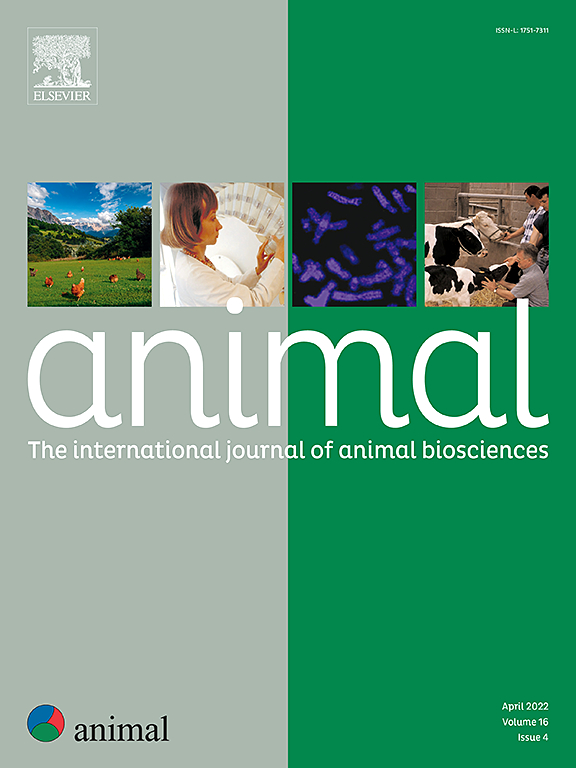How closely do ecosystem services and life cycle assessment frameworks concur when evaluating contrasting animal-production systems with ruminant or monogastric species?
IF 4
2区 农林科学
Q1 AGRICULTURE, DAIRY & ANIMAL SCIENCE
引用次数: 0
Abstract
Life cycle assessment (LCA) and ecosystem services assessment (ESA) are often used for environmental assessment. LCA has been increasingly used over the past two decades to assess agri-food systems and has established that ruminant products have higher impacts per kg of protein than products from monogastric species. Conversely, ESA is used less but is likely to rank ruminant systems higher than monogastric systems, as the former often include grasslands that can provide high levels of regulating ecosystem services (ESs). Here, we applied both methods to a selection of contrasting meat-oriented animal-production systems that included either ruminants or monogastrics (6 of each). We considered 16 environmental impact categories in the LCA and two functional units: 1 kg of human-edible protein (HEP) and 1 m2yr of land occupied. We used the life-cycle inventory step of LCA to characterise the land occupation of the systems, i.e. the land cover types used, such as croplands and grasslands. Based on these land covers and quantification of the ES they provide, we performed ESA. We estimated that ruminant systems had higher environmental impacts than monogastric systems per kg of HEP for all 16 LCA impact categories studied. For example, for ruminants and monogastrics, mean greenhouse gas (GHG) emissions were 280 vs 32 kg CO2-eq., respectively (P = 0.002), and mean fossil energy use was 351 vs 189 MJ, respectively (P = 0.009). The trend was the opposite for impacts per m2yr, with mean GHG emissions of 0.50 vs 0.57 kg CO2-eq. (P = 0.485) and mean fossil energy use of 0.71 vs 3.63 MJ (P = 0.002) for ruminants and monogastrics, respectively. We also estimated that ruminant systems had a higher capacity to supply regulating ES than monogastric systems did, with mean scores of 2.4 and 1.2, respectively (P = 0.002), due to multiple types of grasslands in ruminant systems. Applying both LCA and ESA to a range of contrasting animal-production systems was a novelty of this study, and ESA indicated that ruminant systems have higher positive environmental contributions than monogastric systems. The study also found that LCA and ESA frameworks can agree or disagree on the assessments of animal-production systems depending on functional unit used (i.e. agreement per unit of land occupied but disagreement per unit of HEP).
在评估反刍动物或单胃动物的对比动物生产系统时,生态系统服务和生命周期评估框架的一致性有多高?
生命周期评价(LCA)和生态系统服务评价(ESA)是环境评价常用的方法。在过去的二十年中,LCA越来越多地用于评估农业食品系统,并已确定反刍动物产品比单胃动物产品对每公斤蛋白质的影响更高。相反,ESA的使用较少,但反刍动物系统的排名可能高于单胃系统,因为前者通常包括可以提供高水平调节生态系统服务(ESs)的草原。在这里,我们将这两种方法应用于选择对比鲜明的以肉类为导向的动物生产系统,其中包括反刍动物或单一动物(每种6只)。我们在LCA中考虑了16个环境影响类别和两个功能单位:1公斤人类食用蛋白(HEP)和1平方米的土地占用。我们使用LCA的生命周期盘点步骤来描述系统的土地占用,即使用的土地覆盖类型,如农田和草地。基于这些土地覆盖及其提供的生态系统量化,我们执行了生态系统评估。我们估计,在所有16种LCA影响类别中,反刍动物系统比单胃系统每公斤HEP具有更高的环境影响。例如,反刍动物和单目动物的平均温室气体(GHG)排放量分别为280千克和32千克二氧化碳当量。(P = 0.002),平均化石能源使用量分别为351兆焦耳对189兆焦耳(P = 0.009)。对于每立方米年的影响,趋势正好相反,平均温室气体排放量为0.50对0.57千克二氧化碳当量。反刍动物和单目动物的平均化石能源消耗分别为0.71兆焦耳和3.63兆焦耳(P = 0.002)。我们还估计反刍动物系统比单胃系统具有更高的调节ES的能力,平均得分分别为2.4和1.2 (P = 0.002),因为反刍动物系统中有多种类型的草地。将LCA和ESA应用于一系列对比动物生产系统是本研究的新颖之处,ESA表明反刍动物系统比单胃系统具有更高的积极环境贡献。该研究还发现,LCA和ESA框架对动物生产系统的评估可能同意或不同意,这取决于所使用的功能单位(即每单位占用土地达成一致,但每单位HEP存在分歧)。
本文章由计算机程序翻译,如有差异,请以英文原文为准。
求助全文
约1分钟内获得全文
求助全文
来源期刊

Animal
农林科学-奶制品与动物科学
CiteScore
7.50
自引率
2.80%
发文量
246
审稿时长
3 months
期刊介绍:
Editorial board
animal attracts the best research in animal biology and animal systems from across the spectrum of the agricultural, biomedical, and environmental sciences. It is the central element in an exciting collaboration between the British Society of Animal Science (BSAS), Institut National de la Recherche Agronomique (INRA) and the European Federation of Animal Science (EAAP) and represents a merging of three scientific journals: Animal Science; Animal Research; Reproduction, Nutrition, Development. animal publishes original cutting-edge research, ''hot'' topics and horizon-scanning reviews on animal-related aspects of the life sciences at the molecular, cellular, organ, whole animal and production system levels. The main subject areas include: breeding and genetics; nutrition; physiology and functional biology of systems; behaviour, health and welfare; farming systems, environmental impact and climate change; product quality, human health and well-being. Animal models and papers dealing with the integration of research between these topics and their impact on the environment and people are particularly welcome.
 求助内容:
求助内容: 应助结果提醒方式:
应助结果提醒方式:


